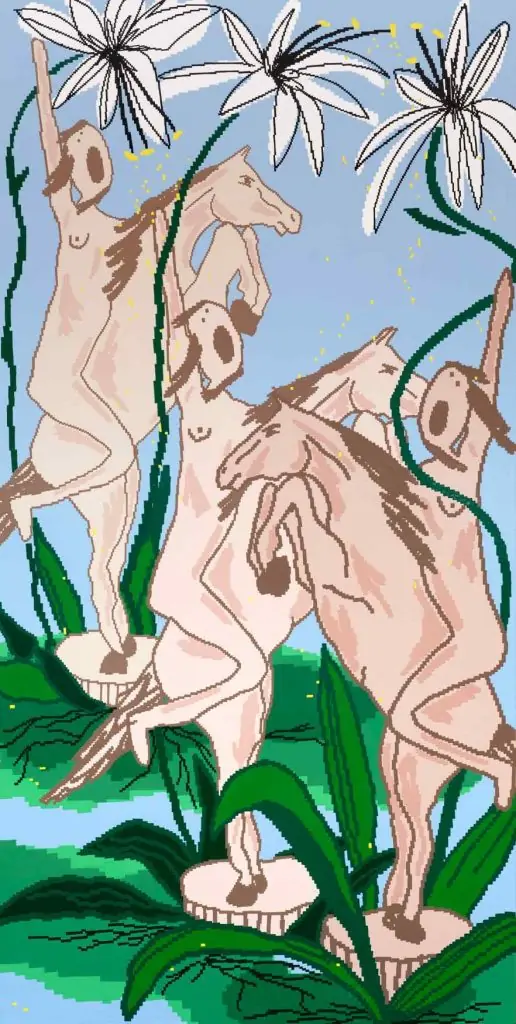Maja Djordevic: Hope and Rebirth
23rd Febuary, 2024 – 16th March, 2024
CARL KOSTYÁL
12A Savile Row
LONDON
W1S 3PQ
Carl Kostyál is delighted to present ‘HOPE AND REBIRTH’ by Belgrade-born artist Maja Djordjevic. This is the artists second solo exhibition with the gallery, following her debut at Carl Kostyál London in 2020. While building her new body of work, now on show at Carl Kostyál, Maja Djordjevic felt as though she was watching the world fall apart.
A uniquely porous individual, Djordjevic internalises others’ pain and experiences it as if it were her own. This quality, both precious and burdensome, often leaves the artist feeling powerless. In the spring, she wrote in her journals, “Za sve one preplakane bitke, gde nisam mogla nista da uradim” (For all the battles I cry, but I couldn’t do nothing).
Unamenable to translation, this polysemous phrase encapsulates the artist’s immense empathy, alongside the search for agency, restoration, equality and tranquillity at the heart of her recent work.

Oil and Enamel on Canvas, 150 x 110cm. Photography by Ben Westoby. Courtesy of Carl Kostyál and the Artist
These longings are unfailingly manifested through Djordjevic’s iconic, nude female figure – a character she affectionately refers to as “My Girl”. Across the six works on show, Djordjevic’s girl takes on a multitude of novel embodiments – the heroic leader (‘I fear there is no one to save me’), the quintessence of solidarity (‘We Sympathise! We Do!’) and the human-plant hybrid (‘Hope and Rebirth!’) – each emblemising the promises held within the show’s title. More reminiscent of the symbol for a woman than any real individual, Djordjevic’s figures are deployed as relatable storytelling devices. In their lack of specificity, they invite the viewer to find identification and empowerment: like Djordjevic’s girl, they too can be the hero.
Another symbol, a leitmotif that grows throughout the exhibition, is the lily. From antiquity to the present day, flowers have been a constant subject of artistic interest: botanical illustration dates back to the work of Greek physician Krateus in the 1st century B.C., Dutch painters of the 17th century imbued bouquets with connotations of life or death, and world-renowned modernist Georgia O’Keeffe transformed depicting the folds of a petal into a deeply radical gesture. Acknowledging this legacy, in ‘HOPE AND REBIRTH’ Djordjevic employs flowers as emotional conduits and symbolic devices.

In ‘Memorial Roots’ seven girls cower beneath a canopy of Convallaria majalis (Lily of the Valley). Steeped with cultural significance, the Lily of the Valley is often associated with chastity, purity, sincerity and happiness. Common place in painterly depictions of the Annunciation, Christians have long since affiliated the flower with the coming of Christ.
Another parable, one which perhaps more aptly captures Djordjevic’s sentiments, is the story of Eve’s banishment from the garden of Eden; it is often thought that the Lily of the Valley first grew from puddles of Eve’s tears. With this in mind ‘Memorial Roots’ becomes a monument to women’s suffering throughout the ages. Hiding among the fruit of Eve’s tears, the girls pictured refuse to cry silently or leave quietly, as Eve did, and instead find their voice – their gaping red mouths present as reminders
that they will not be ignored.
Another piece, ‘When it’s time you might not want to go’ looks to the flower most famously depicted by Claude Monet – the Nymphaeaceae (Water Lily). Painting little but the water garden at his Giverny estate in Normandy, Monet worked tirelessly on his Water Lilies Series for more than three decades. In 1918, he took the decision to bequeath a significant number to the French state, intending to finish and sign them on “Victory Day”.
Monet’s pieces can thus be understood through multiple perspectives: an intense act of artistic discipline through restricting oneself to a single subject, an endless ode to natural beauty and the majesty of nature, or, perhaps most appropriately in this case, a monumental symbol of peace. On creating ‘When it’s time you might not wanna go’, Monet’s generous gesture lingered in Djordjevic’s mind. This piece, featuring a floating mass of girls reaching up towards the sky from within a seemingly endless lake, sees Djordjevic resurrecting these flowers’ associations with peace to call for a contemporary global armistice.

Oil and Enamel on Canvas, 130 x 250cm. Photography by Ben Westoby.
Courtesy of Carl Kostyál and the Artist
Nestled amongst the women, sprigs of Nerine sarniensis (Guernsey Lily) appear triumphantly. Emerging in autumn despite harsh conditions, these magnificent blooms are paragons of hope and resilience.
Their inclusion in ‘When it’s time you might not wanna go’, alongside the bobbing Water Lilies, therefore underlines Djordjevic’s salient message – that even if you are drowning within a sea of conflict, you must never lose hope for a peaceful future.
This optimism, and Djordjevic’s considered engagement with art history, underpins another piece on show, ‘I fear there is no one to save me’. Reminiscent of Eugène Delacroix’s iconic painting ‘Liberty Leading the People’ (1830), Djordjevic’s composition features a single girl triumphantly waving a Spathiphyllum (Peace Lily) as if it were a white flag.
In evoking Delacroix’s masterpiece, a grand history painting commemorating the July revolution of 1830, Djordjevic allows her piece to become a transhistorical meditation on freedom from oppression. By recalling a memorable peoples’ uprising, and allowing her girl to subsume the position of Lady Liberty, she invites modern audiences to consider the forces to which they are subjugated while reminding them they can break free.
Maja Djordevic: Hope and Rebirth opens on the 23rd of Febuary, 2024 until the 16th of March, 2024 at CARL KOSTYÁL
©2024 CARL KOSTYÁL





